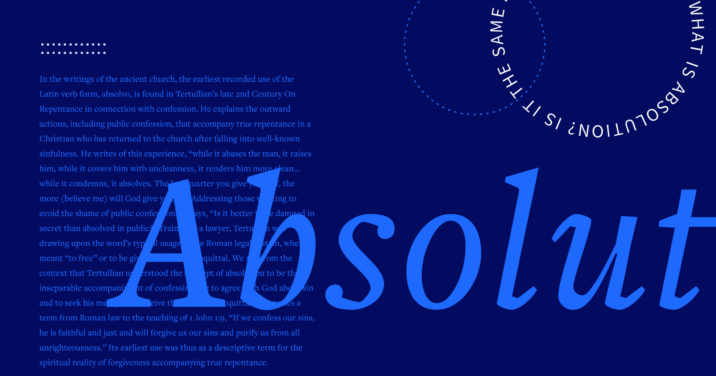As interest in traditional churches and liturgy has grown among evangelicals, there is also growing curiosity about liturgical terms and actions such as confession, absolution, and benediction.
Because the word “absolution” has changed in meaning across church history, accumulating and shedding signification in turn, the use of the word might need a disclaimer. Since the Reformation, the Protestant meaning of absolution differs in significant ways from the Roman Catholic and Eastern Orthodox uses; the Protestant use recuperates ancient rather than medieval practice. Protestant churches that use an absolution in their services should take care that they are communicating the ancient, biblically formed practice as an announcement of God’s promised forgiveness.
Table of contents
Where does the term “absolution” come from?
In the writings of the ancient church, the earliest recorded use of the Latin verb form, absolvo, is found in Tertullian’s late second-century On Repentance in connection with confession. He explains the outward actions, including public confession, that accompany true repentance in a Christian who has returned to the church after falling into well-known sinfulness. He writes of this experience,
While it abases the man, it raises him, while it covers him with uncleanness, it renders him more clean. … while it condemns, it absolves. The less quarter you give yourself, the more (believe me) will God give you.1
Addressing those wanting to avoid the shame of public confession, Tertullian also says, “Is it better to be damned in secret than absolved in public?” Trained as a lawyer, Tertullian was drawing upon the word’s typical usage in the Roman legal system, where it meant “To free from bonds, release” or “to find not guilty of a charge, acquit.”2 We see from the context that Tertullian understood the concept of absolution to be the inseparable accompaniment of confessing sin: to agree with God about sin and to seek his mercy is to receive the verdict of acquittal. He applies a term from Roman law to the teaching of 1 John 1:9, “If we confess our sins, he is faithful and just and will forgive us our sins and purify us from all unrighteousness.” The earliest use of “absolve” among Christians was thus as a descriptive term for the spiritual reality of forgiveness accompanying true repentance.
Even in Tertullian’s time, the public confession he describes, called exomologesis, was already part of a ceremony for the reconciliation of notorious sinners, a ceremony which normally took place shortly before Easter. Men and women whose sin had become public and had damaged the church’s integrity were excluded from church fellowship. Those who became truly penitent could be restored after demonstrating earnest desire for reconciliation. Although part of the rite included a formal announcement of the sinner’s reconciliation to the church, we can see from Tertullian’s text that this announcement was not in fact called absolution at the end of the second century. Rather, Tertullian emphasizes the spiritual benefits inherent in the humility of public confession, including the penitent’s standing as absolved by the Holy Spirit.
In the earliest surviving liturgies of the church, we see a similar emphasis on the spiritual inseparability of verbal confession and standing absolved (or free) of blame. In every ancient liturgy, a formal and general confession always features as part of the Lord’s Supper, whether it is spoken by the congregation or prayed by the pastor on behalf of the people. The service then proceeds—without a verbal statement of absolution—to the celebration of communion with repeated thanks for Christ’s redemptive work to forgive sin. Thus, a shift in the prayers from petitionary—“forgive, remit, pardon, O God, our transgressions, voluntary and involuntary”—to declaratory of peace—“peace be to all”—indicates the church’s faith in God’s forgiveness whenever believers sincerely confess sin.3
How did a formal absolution arise?
By the late fourth century, the rite of reconciliation of those fallen into sin had become more formalized. The church had faced crises in which thousands had denied Christ under threat of torture and death, and many later desired to return. The process of their reconciliation to the church was completed by public confession of their denial and the pastor’s declaration that their sin of apostasy and abandoning their brethren would no longer be held against them.
Augustine explains two dimensions of this restoration:
When you hear a man is sorry for his sins, he has already come to life again; when you hear him through [public] confession lay open his conscience, he is already drawn forth from the grave, but he is not as yet loosed. When is he loosed, and by whom is he loosed? “Whatsoever you loose on earth,” [Christ] says, “shall be loosed in Heaven.” Fittingly the church may give the loosening [solutio] of sins: but the dead man himself cannot be revived except by the Lord calling within him; for God moves this within him.4
In other words, God alone can forgive sins and deal with their eternal consequences, but the church has authority on earth to set aside the earthly consequences that alienate a person from his or her community, thereby providing the assurance of standing in God’s mercy. Following the usage of Tertullian, Augustine distinguishes between the invisible working and the visible working, yet recognizes that acts of the visible church have spiritual consequences in the life of a person and the corporate life of a church community.
By the middle of the fifth century the Latin term for absolution was firmly connected with this act of a priest formally declaring the forgiveness of a repentant person who had been excluded from communion. Leo I of Rome uses the terms “reconciliation” and “absolution” interchangeably.5 Through subsequent centuries, leading voices of the church including Anselm, Peter Abelard, Bernard of Clairvaux, and Peter Lombard took differing views on whether the pastor’s statement of absolution produced any change in the confessing person’s spiritual state or was simply declaring what God had already done. In the liturgical life of the worshiping church, however, confession continued to be part of the communion service, with forgiveness being celebrated but not stated through a formal absolution.
The later innovation that now brings confusion to evangelicals was the introduction of the statement, “I absolve you,” into private confession. Although private confession amongst laity or to a clergyperson has been a feature of Christian life from the beginning of the church, it was not until the thirteenth century that the church authorized priests to use the indicative formula, “I absolve you,” and Thomas Aquinas followed church practice by elaborating a justification for it. He taught that a person who sins after baptism could not be reconciled to God without a priest’s absolution, using the formula, “I absolve you.”6 During the high medieval period from 1300 until the Reformation, this view of necessary private confession and a priestly absolution held sway.
Absolution in the English Reformation
One of the principle targets of the English Reformation was clericalism, which implies a special status or spiritual powers held by ordained people. The reformers wrote against clergy who had taken on powers to assign penances and assess fines in exchange for absolution, which included private confession as the vehicle for exercising this power.
And yet the reformers were content to continue using the traditional terms in their project of reformation, discussing the need for penitence, absolution, and satisfaction, within a framework of sacrament, rite, and ceremony. They were critical not of the terms, necessarily, but of the practices associated with them and the assumptions behind them. Their reforming work thus shifted the place of confession and explicit absolution away from the medieval norm of private confession and into the corporate worship service, where the people could understand that confession is made to God, and the pastor’s role is to declare God’s promised forgiveness. This declaration of forgiveness retained the term absolution, but in the context of worship it now unambiguously applied to the people’s common confession. Returning to the earliest use of the word by Tertullian, the reformers understood absolution to be a spiritual reality received by every person confessing with true repentance. The pastor’s role, in their view, was simply to offer the assurance of pardon to the truly repentant.
While the English church continued to allow for private confession in the case of a delicate conscience overwhelmed by sin, private absolution came “by the ministry of God’s holy Word [through which a sinner] may receive the benefit of absolution … to the quieting of his conscience, and avoiding of all scruple and doubtfulness.”7 Therefore, in both the general confession in worship and the rare private confession, absolution was declaratory of promises made in Scripture. Not surprisingly, the exceptions to this rule are in the rite for reconciling penitents and those on the point of death, in which the parish priest speaks according to the second sense in ancient usage as releasing the offender from excommunication. The reformer Archbishop Thomas Cranmer shows the intention:
Before this church, the government of which has been entrusted to me, I absolve you of the penalty of your transgressions and release you from the bonds of excommunication.8
The meaning of absolution here could not be clearer.
Is absolution biblical?
Absolution is inextricably linked with confession. We might first be clear how important confession appears to be throughout the Bible. Proverbs 28:13 says helpfully,
He who conceals his sins does not prosper,
but whoever confesses and renounces them finds mercy.
There are at least three basic types of confession in the Scriptures.
1. Confession to God
As David said, “Against you, you only have I sinned”—every sin is rebellion against God and a turning from his goodness. To confess is to agree with God that sin is worthy of punishment. For example:
- Exodus 32, Numbers 14—Moses confesses on behalf of the rebellious Israelites.
- 2 Chronicles 6—Solomon confesses Israel’s frequent waywardness.
- Psalm 32, 51—David’s personal confession models an open heart of repentance.
- 2 Chronicles 29–30, 35—Confession is embedded in the renewed Passover under Hezekiah and Josiah, along with the kings’ modeling behavior of penitence.
- Daniel 9—Daniel confesses his people’s sin in response to realizing the prophesied end of Judah’s captivity in Babylon.
- Nehemiah 1—Nehemiah confesses his people’s sin as he longs for their renewal.
- Nehemiah 9–10—Ezra the priest leads the nation in corporate repentance followed by covenant renewal.
- Luke 5—In response to the miraculous catch of fish, Peter confesses, “Go away from me, for I am a sinful man, O Lord.”
- 1 John 1:9—“If we confess our sins, he is faithful and just and will forgive us our sins and cleanse us from all unrighteousness.”
- 1 Peter 5:5–6—“‘God opposes the proud but gives grace to the humble.’ Humble yourselves, therefore, under the mighty hand of God so that at the proper time he may exalt you.”
2. Confession to another
- Matthew 5:23–26—Jesus teaches the necessity of confession to a brother and pursuing reconciliation.
- James 5:16—“Confess your sins one to another, and pray for each other that you may be healed.”
3. Confession to the congregation
- 1 Corinthians 5, 2 Corinthians 2—The case of public sin that affects the whole congregation—“a little leaven leavens the whole lump”—requires excommunication in order that the offender might repent. If the excommunication was public, the restoration would likewise be public.
We find, then, that confession has always been practiced by God’s people. But how does absolution connect with the biblical accounts?
Biblical absolution
In all these cases, God’s forgiveness is understood to accompany the confession. We might even say that without God’s prior willingness to forgive, the sinner could not confess, as the Spirit’s work is to “convince the world concerning sin and righteousness and judgment” (John 16:8). The one who confesses is thereby absolved—cleansed from unrighteousness (1 John 1:9). It was on this basis that the declaration of absolution was first practiced.
Taking up the second sense of absolution, the restoration of the excommunicated brothers in 1 and 2 Corinthians would require the elders of the local Corinthian church to announce that the community has forgiven them. Because they were publicly excluded, e.g. 1 Corinthians 5:3–5 and 2 Corinthians 2:5–11, the community would need a public announcement that they have been restored, and that the church forgives the damage done to their fellowship and reputation. These biblical moments in Corinth are the earliest Christian instances of a rite for the reconciliation of a penitent.
The authority to declare absolution: what it is and isn’t
The authority to perform the action of excommunication and restoration was granted by Jesus to his disciples in Matthew 16:17–19 and 18:15–18.
Blessed are you, Simon Bar-Jonah! For flesh and blood has not revealed this to you, but my Father who is in heaven. And I tell you, you are Peter, and on this rock I will build my church, and the gates of hell shall not prevail against it. I will give you the keys of the kingdom of heaven, and whatever you bind on earth shall be bound in heaven, and whatever you loose on earth shall be loosed in heaven.
If your brother sins against you, go and tell him his fault, between you and him alone. If he listens to you, you have gained your brother. But if he does not listen, take one or two others along with you, that every charge may be established by the evidence of two or three witnesses. If he refuses to listen to them, tell it to the church. And if he refuses to listen even to the church, let him be to you as a Gentile and a tax collector. Truly, I say to you, whatever you bind on earth shall be bound in heaven, and whatever you loose on earth shall be loosed in heaven.
Although these texts are often raised to defend the medieval concept of priestly absolution, they refer instead to church discipline and the power of truth to act according to God’s will. Jesus speaks in the language of his context. In rabbinic literature, to “bind and loose” typically mean to “forbid and allow” respectively. They are also used to mean excommunicating (binding) and restoring (loosing) to the synagogue. To Peter, Jesus gives the truth of the kingdom, the keys that unlock the doors “shut in men’s faces” by the Pharisees and teachers of the Law (Matt 23:13). Following the Lord Jesus in the wisdom of the Spirit, he and other leaders of the church are empowered to interpret the Law and establish church practices.
More obviously referring to church discipline, in the Matthew 18 passage Jesus empowers the disciples generally to determine what behavior will lead to excommunication (binding) and what leads to freedom in fellowship (loosing). The Spirit will lead them to judge in accordance with the ways of heaven. That he is describing the actions rather than the people is clear from his repeated “whatever you bind” rather than “whoever you bind.” This authority, which the Council of Jerusalem exercised through its decisions in Acts 15 and Paul exercised in Corinth, is the biblical basis for absolution in the context of reconciling a penitent person in church discipline.
Finally, Jesus’s statement on the evening of his resurrection is famously difficult to understand:
Receive the Holy Spirit. If you forgive anyone his sins, they are forgiven; if you do not forgive them, they are not forgiven. (John 20:22–23)
Given that none of the apostles or other disciples present on the occasion are recorded as directly forgiving a person’s sins, they seem to have understood his statement as consistent with his earlier instructions recorded in Matthew. But here they are spiritually empowered to do it. As shepherds of the community of faith, they are authorized to embrace or exclude a sinful person from fellowship, as well as to establish the boundary lines for those decisions.
Absolution today
In the Roman Catholic and Eastern Orthodox churches, absolution follows the medieval understanding established by Thomas Aquinas. Priests in these traditions hold on both to the practice of private confession and to the authority to grant forgiveness of sins. Catholics in particular hold that mortal sin can only be forgiven through priestly absolution. In both private confession and the general confession, absolution is granted on the basis of a priest’s authority given through his ordination.
Protestants, standing in the Reformation tradition, maintain that their view of absolution marks a return to ancient church understandings. The announcement of absolution following the congregational confession is spoken on the authority of God’s Word. It is a declaration of God’s promised forgiveness to all who repent (Matt 11:28, John 3:16–18, Acts 2:38–39, Acts 26:18, 1 John 1:9, 2:1–2). This absolution either declares the promised forgiveness, “God forgives us in Christ”; or it prays for it in faith, “May God grant you the forgiveness of your sins.”
In Protestant churches that practice church discipline, rites of reconciliation also sometimes include an absolution according to the second sense as loosing a penitent from the ban on participation in communion. Again attempting to conform custom to biblical teaching, this absolution is understood as forgiveness by the community for harm brought to its fellowship (1 Cor 5:3–5, 2 Cor 2:5–11).
Because these traditions have differing understandings, “absolution” is ambiguous, a technical term with different meanings in different traditions. Especially for those coming from non-denominational, evangelical churches, the medieval Roman Catholic notion casts a large shadow over the practice. Consequently, church leaders should take care to communicate what they mean by the term “absolution.” Let’s be clear that Protestants follow the early centuries of the church, declaring absolution as the inherent spiritual reality accompanying true confession. Better still, Anglicans, Lutherans, Reformed churches, and other liturgical communities might cast off the term but hold on to the practice. Let’s continue to “confess [our] sins one to another,” assuring each other of our freedom from condemnation. And let’s confess together as local bodies of Christ, receiving the announcement of our freedom in Christ through the mouths of our pastors. Finally, when we restore those who have fallen in a public way, let’s also publicly declare that we no longer hold their offenses against them.
Related articles
- What Does ‘Binding and Loosing’ Mean in Matthew 16:19?
- The Unforgivable Sin: Evidence You Have Not Committed It
- Is Repentance a Change of Mind or Something Different?
Recommended resources
Tertullian: Treatises on Penance – On Penitence and On Purity (Ancient Christian Writers)
Regular price: $21.99
- Tertullian, Tertullian: Treatises on Penance: On Penitence and On Purity, Cap. 9.
- P. G. W. Glare, “absoluō,” in Oxford Latin Dictionary, 2nd ed. (Oxford: Oxford University Press, 2012).
- C. E. Hammond, “Liturgy of St. James” in Liturgies Eastern and Western (Oxford: Clarendon Press, 1878).
- Augustine of Hippo, Expositions on the Book of Psalms: Psalms 1–150, vol. 5, A Library of Fathers of the Holy Catholic Church (Oxford; London: F. and J. Rivington; John Henry Parker, 1847–1857), 21.
- St. Leo the Great, “108. Bishop Leo, to Theodore, Bishop of Forum Julii (June 11, 452),” in St. Leo the Great: Letters, trans. Edmund Hunt, The Fathers of the Church (New York: Fathers of the Church, 1957), 190.
- Thomas Aquinas, Questions 84–90 in Summa Theologica, trans. Fathers of the English Dominican Province (London: Burns Oates & Washbourne, n.d.).
- “The Order for the Administration of the Lord’s Supper” in The Book of Common Prayer from the Original Manuscript: Attached to the Act of Uniformity of 1662 (London; Edinburgh; Glasgow; Melbourne; Sydney; New York: Eyre & Spottiswoode, 1892), 244.
- “A Form for Reconciling Excommunicates,” in Tudor Church Reform: The Henrician Canons of 1535 and the ‘Reformatio Legum Ecclesiasticarum,’ ed. Gerald Bray, vol. 8, Church of England Record Society (Woodbridge: Boydell Press, 2000), 488–89.







